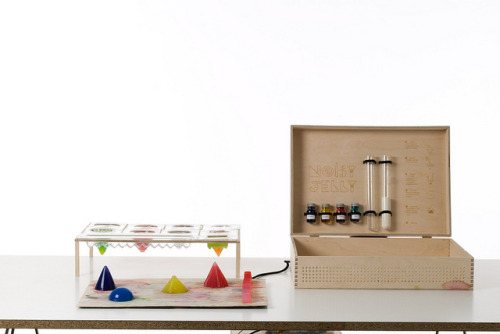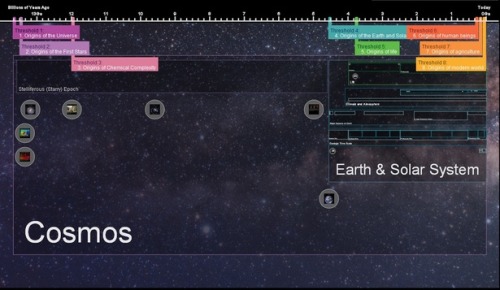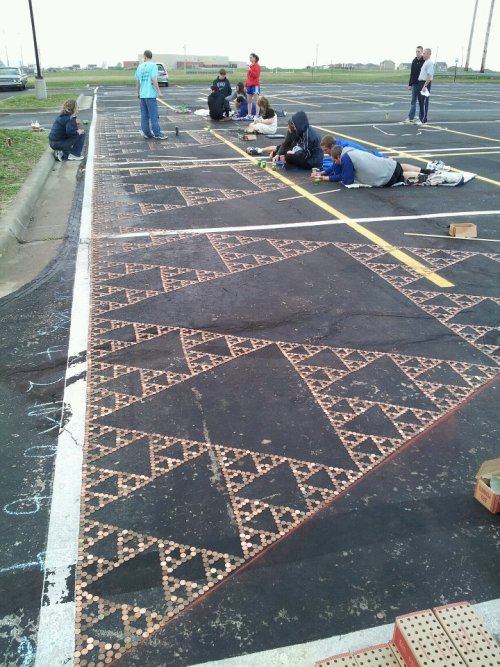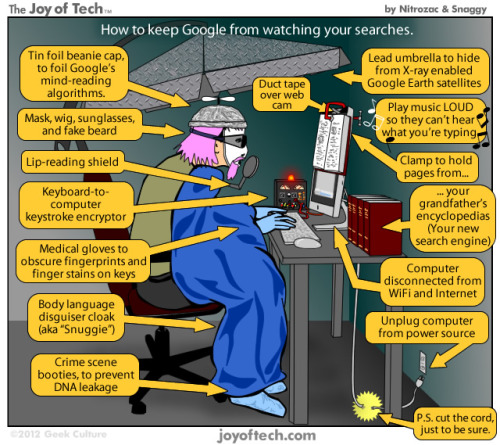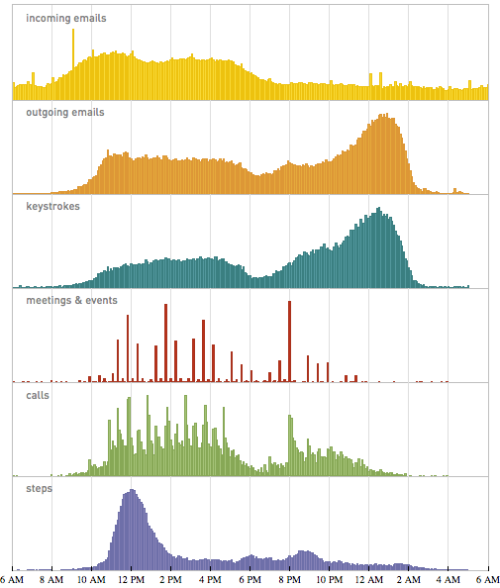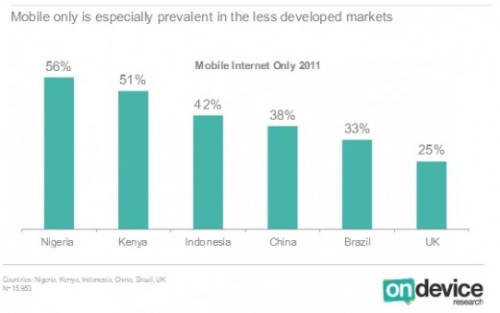Saturday, March 31, 2012
Friday, March 30, 2012
Lecture: Humanize your Data
This video is a bit long, but Jer Thorp, a creative computer geek, keeps you pretty entertained the whole time and he has some really funky graphs making data quite aesthetic. I think it’s worth watching to the end to hear him make his point about how we need to put data in a human context, to tether it to the real world and give it real meaning.
Source: TED
Tech: Military Robotics
Robotic arms precise enough to lift a light bulb, yet strong enough to lift a set of weights. Robots that can search suspicious territory first without requiring a human being. Robots that can push around suspicious cars, break into them and take out the explosive device, safely away from any humans.
Representatives from robotics companies including iRobot and HDT Robotics, as well as government developers, were in attendance at an annual robotic conference which was held this year on Harbor Island in San Diego.
Source: SBS World News
Humor: If you Lined up all the Elephants…
Photo: Lava Crater
Another amazing capture from ESA astronaut André Kuipers, from his vantage point on the International Space Station. André travelled to the orbital outpost in December 2011, and will remain in orbit for more than 6 months as part of ESA’s long duration mission, PromISSe.
Thursday, March 29, 2012
Astronomy: Aperture Spherical Radio Telescope
"A Big Eye on the Sky" by Guillermo Munro
The 500-meter Aperture Spherical radio telescope (FAST) will take over as the biggest radio telescope in the world. The amazing thing about FAST is that is gigantic and still it’s able to move in angles and change its radius. Its being constructed in the beautiful valley of Guizhou in South China and will be completed in just over four years. The Telescope will be able to help scientists see the origin of the Universe, dark matter and look for extraterrestrial life.
Source: China Daily
News: James Cameron's Record-Breaking Trench Dive
James Cameron Completes Record-Breaking Mariana Trench Dive:
Explorer and filmmaker James Cameron reached the deepest part of the Pacific Ocean at 7:52 am Monday local time (2152 GMT Sunday) in his specially designed submersible. He is the first person to dive there solo and reach a depth of 35,756 feet (10,898 meters), since it was initially explored in 1960.
Gadgets: Noisy Jelly
Noisy Jelly is a learning game in which kids make their own electronic music instruments out of jelly. When placed on the game board, the jelly shapes become capacitive sensors and play sounds whenever they are touched. Noisy Jelly is a design concept by French design students Raphaël Pluvinage and Marianne Cauvard. Via: MAKE
Science: Geologic Time Scale
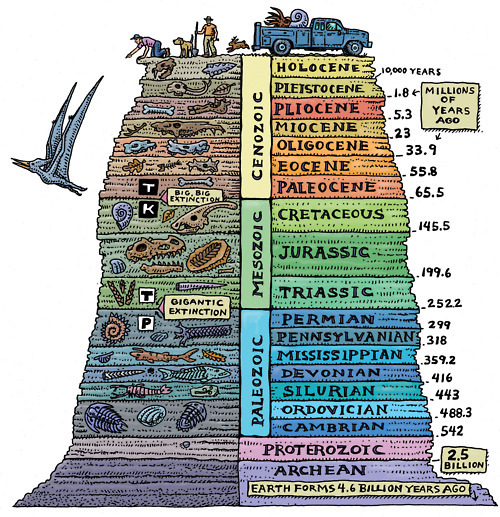
Illustrated Geologic Time Scale
One of the coolest nuances about our planet earth is that it curates its own museum of natural history through the fossil record. It is truly remarkable that tangible specimens of early invertebrates, the first jawed fishes, primitive amphibians, the first feathered dinosaurs (who grandfathered all modern birds!), and many, many proto-humans have been preserved til present day. The tree of life is a grand old thing, of which we're just one small branch!
I’d like this chart more if it had the Carboniferous rather than American name. It ought to read Precambrian, Cambrian, Ordovician, Silurian, Devonian, Carboniferous, Permian, Triassic, Jurassic, Cretacious, Tertiary, Quarternary. Just remember the mnemonic, "Pregnant Camels Often Sit Down Carefully, Perhaps Their Joints Creak Too Quietly."
Gadgets: The Tricorder Project
One of the most beautiful aspects of science is that while there is so much we can see and smell and feel around us, there's an inconceivably large universe around us full of things we can't directly observe. The Tricorder project aims to develop handheld devices that can sense a diverse array of phenomena that we can't normally see, and intuitively visualize them so we might see temperature or magnetism or pressure as naturally as we see colour.
Tech: NUIverse
Demonstration of the NUIverse application designed by David Brown for the Samsung SUR40 for Microsoft Surface.
Photo: Grand Star-Forming Region
This massive, young stellar grouping, called R136, is only a few million years old and resides in the 30 Doradus Nebula, a turbulent star-birth region in the Large Magellanic Cloud. There is no known star-forming region in the Milky Way Galaxy as large or as prolific as 30 Doradus.
Many of the diamond-like icy blue stars are among the most massive stars known. Several of them are 100 times more massive than our sun. These hefty stars are destined to pop off, like a string of firecrackers, as supernovas in a few million years.
Wednesday, March 28, 2012
Gadgets: The Sand Flea
Damn! Gone are the decades in which we could escape the Daleks by running up a staircases.
Sand Flea is an 11-lb robot with one trick up its sleeve: Normally it drives like an RC car, but when it needs to it can jump 30 feet into the air. An onboard stabilization system keeps it oriented during flight to improve the view from the video uplink and to control landings. Current development of Sand Flea is funded by the The US Army's Rapid Equipping Force. For more information visit Boston Dynamics.
Video Distraction: Perpetual Ocean
This visualization shows ocean surface currents around the world during the period from June 2005 through Decmeber 2007. The visualization does not include a narration or annotations; the goal was to use ocean flow data to create a simple, visceral experience.
This visualization was produced using NASA/JPL's computational model called Estimating the Circulation and Climate of the Ocean, Phase II or ECCO2.. ECCO2 is high resolution model of the global ocean and sea-ice. ECCO2 attempts to model the oceans and sea ice to increasingly accurate resolutions that begin to resolve ocean eddies and other narrow-current systems which transport heat and carbon in the oceans.The ECCO2 model simulates ocean flows at all depths, but only surface flows are used in this visualization. The dark patterns under the ocean represent the undersea bathymetry. Topographic land exaggeration is 20x and bathymetric exaggeration is 40x.
Photo: Mosaic of the Galactic Center
This composite color infrared image of the center of our Milky Way galaxy reveals a new population of massive stars and new details in complex structures in the hot ionized gas swirling around the central 300 light-years.
This sweeping panorama is the sharpest infrared picture ever made of the Galactic core, revealing details in objects as small as 20 times the size of our own solar system. The picture measures 300×115 light-years and required 144 Hubble orbits to make 2,304 science exposures. It was taken between Feb. 22 and Jun. 5, 2008.
Tuesday, March 27, 2012
Gadgets: Robotic Mobility Device for Paraplegics
The TEK Robotic Mobility Device allows people who cannot walk due to spinal cord injury to stand up and move around with independence. As this intro video shows TEK RMD users can board the device without assistance, perform everyday tasks like cooking and shopping, and interact with others at eye level. TEK RMD was created by AMS Mekatronic, a Turkish research and development company. Via: Reuters
Net: Google Tour of the Amazon
Last August, Google sent a team to Brazil to create Street View maps of some of the waterways, forests, and villages of the Amazon Basin.
Video Distraction: Giant Paper Airplane Flies
On March 21, the PIMA Air & Space Museum successfully launched a 45 foot long paper airplane from a helicopter in the skies over Arizona. This video is our first glimpse into the dramatic, historic flight. Via: CNET News
Interview: Futurist Stowe Boyd
IBMSocialBiz ( IBM blogger Todd Watson) interviews Stowe Boyd at South By Southwest Interactive 2012 (SXSWi 2012) from the IBM Future of Social Lounge. Boyd talks about Cluetrain, the social revolution online, work media tools, the impact on media companies, the changing way we read, and his upcoming ebook, The Business Of Social Business.
Labels:
future,
interview,
social media,
technology,
video
Monday, March 26, 2012
OpEd: Super Mario Bros is Surrealist Art
We all know who the Mario Brothers are but have you ever stepped back and tried looking at those games from a fresh perspective? Like you've never seen or heard of them before? They're bananas! There are armored turtles who stand on their hind legs and steal princesses! There are bullets with FACES! We make a case for Mario's inclusion into a canon of art wider than "Video Game": we think Mario is a piece of surrealist artwork.
Factoid: Lichtenberg Figure
A “lightning flower”or Lichtenberg Figure is the scarring that occurs on the skin of lightning strike victims, most likely as a result of small capillaries bursting from the intensity of the lightning bolt’s current.
Video Distraction: Robot Barber
The Multi-Arm UGV (Unmanned Ground Vehicle) demonstrates its dexterity by shaving a volunteer's head to raise money for the St. Baldrick's Foundation, a charity committed in funding research for finding a cure for childhood cancer.
Interview: Futurist Gerd Leonhard
Interview recorded during Digital London with Gerd Leonhard, Futurist, Author and CEO of The Futures Agency.
Lecture: Militarizing Your Backyard
Militarizing your Backyard with Python: Computer Vision and the Squirrel Hordes
Has your garden been ravaged by the marauding squirrel hordes? Has your bird feeder been pillaged? Tired of shaking your fist at the neighbor children? Learn how to use Python to tap into computer vision libraries and build an automated sentry water cannon capable of soaking intruders.
Labels:
lecture,
programming,
tutorial,
video,
weapons
Astronomy: If Earth Had Saturn-Like Rings
YouTube user Roy Prol created this fascinating animation that imagines what Earth would be like if our planet had Saturn-like rings. In addition to views from space, he show us beautiful renderings of what the rings would look like in landscape photos captured at famous landmarks (e.g. the Eiffel Tower in Paris, Christ the Redeemer in Rio de Janeiro) around the world.
Tech: Becoming the Cyborg Chauffeur
Connected cAR: Becoming the Cyborg Chauffeur:
The car is apparently one of the next battlefields for ownership of our personal data and privacy. It is an intimate environment and there will soon be enough sensors to document every human habit and behavior within it. While cars will become the panoptic reporter to our every move, people will also be burdened with an overwhelming amount of data ostensibly aimed at “aiding” them in the driving task. There will be touch activated windshields, Augmented Reality (AR) navigation lines projected onto the windshield that guide drivers on a track of navigation, and the blending of both scenarios with the addition of ads showing up on screen. Audio feedback based on sensor activity is currently available as a service in certain commercial vehicles. Installed sensors monitor driver behavior and provide immediate audio feedback if a driver changes lanes suddenly, is speeding or engages in other unsafe behaviors.
Imagine being on the road in a “connected car.” You’re driving, being assisted by various on screen windshield AR applications that guide you through traffic, map your route and suggest places to stop along the way that you might want to visit. Furthermore, you still have the capability to make and answer calls, tell an agent how to respond to email etc… all while driving. You might be drinking a coffee or having a snack as well.
Source: The Society Pages
Tech Links: March 26, 2012
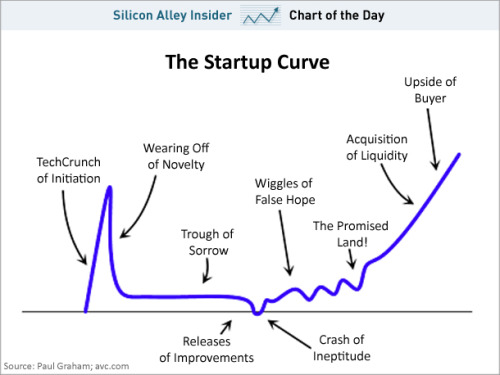
The Startup Curve designed by Paul Graham of Y Combinator
Entertainment
Infographic: How Social Media Sites Make Their Money
Infographic: The Neurology Of Gaming
Google now has street view of the Amazon basin.
5 Ways to Beat Old-School Games Using Math
What do all the controls in an airplane cockpit do?
Gadgets
Everything you need to know about the new iPad
News
The FBI fails to break through a pimp's Android pattern lock, serves Google warrant
Study reveals Americans lost $30 billion worth of mobile phones last year
This American Life retracts episode on Apple and Foxconn
Reading & Discussion
5 Things I Learned About Entrepreneurship From Y Combinator's Paul Graham
The Origins of Futurism
Where’s _why? What happened when one of the world’s most unusual, and beloved, computer programmers disappeared.
Resources & Software
Bouncr is a service that provides free, short email addresses that automatically forward to your real email address. If a bouncr email address begins receiving unwanted messages, the user can simply delete the account.
The Hacker Shelf is nice crowd-sourced guide to (legally) free books on various computational and mathematical subjects. The topics page gives you an idea of the breadth of material available.
Software
Attacking the Washington, D.C. Internet Voting System (PDF). "When we inspected the terminal server’s logs, we noticed that several other attackers [from Iran, New Jersey, India, and China] were attempting to guess the SSH login passwords." J. Alex Halderman, a computer scientist at the University of Michigan, describes how thoroughly he and his team were able to penetrate a pilot Internet voting system run by the District of Columbia, as part of an open public test in 2010. An earlier report on the attack.
OpEd: If you have news, it will be aggregated
If you have news, it will be aggregated and/or curated:
More than anything, it means that trying to recreate the scarcity of content that used to exist in print — when media outlets controlled not only the creation of news but the platforms through which it was distributed — by using paywalls and subscription apps is fundamentally a losing battle. Many users want that content to be part of a larger digital experience, whether it’s through an aggregation app like Flipboard or through Facebook or Twitter. If your content is not designed to take advantage of that, you will be missing a larger and larger proportion of the audience you need.Source: Gigaom
One response to that is to shrink your audience down to those who will pay, as some outlets like the Financial Times have done and several of Rupert Murdoch’s British papers are trying to do. The other approach is to be as open and distributed as possible, to try to take advantage of the democracy of distribution instead of fighting it, and then to find other ways to monetize that audience and their attention, whether it’s e-books or live events or the “reverse paywall” model Jeff Jarvis and others have proposed. Either way, aggregation and curation are the new reality of media, whether media companies like it or not.
Study: Top 5 Sites Visited While Watching TV

In Nielsen’s U.S. Digital Consumer Report, we were given a glimpse of the extent consumers are connected while watching TV. The world’s greatest attention magnet now meets the world’s coolest digital water cooler.What’s clear is that connected consumers are also seasoned multi-taskers. When asked what they’re doing on their devices while watching TV, the top 3 activities included:
1. Checked email - 57%
2. Surfed the Web - 44%
3. Visited a social network - 44%
The study hinted that there's still hope for advertisers, though. 19% of smartphone and tablet owners searched for product information while 16% looked up coupons or deals.
Tech Links: ChronoZoom
Can a new website help us comprehend just how little time has passed since humans appeared on Earth? ChronoZoom is an infinitely expandable timeline of "big history" -- a field of history not focused on, say, the Renaissance or the 20th century, but of the entire universe, all 13.7 billion years of it. Using ChronoZoom, you can navigate from era to era, and zoom far into the details of particular periods, where you'll find little curated "exhibits" about the major events of that time.
Study: Children whose minds wander
"A study has found that people who appear to be constantly distracted have more “working memory”, giving them the ability to hold a lot of information in their heads and manipulate it mentally.""Children whose minds wander 'have sharper brains'"
The Telegraph, March 16, 2012
Daily Links: March 26, 2012

Infographic: The Learning Power Of Lego
20 Criminal Cases Solved By Using Facebook
25 Facts You Should Know About Your Gray Matter
Cheating casinos as a good Christian: Group members believed what they were doing was consistent with their faith because they felt they were taking money away from an evil enterprise. Further, they did not believe that counting cards was inherently a bad thing; rather, it was merely using math skills in a game of chance.
Here's how to make The Perfect Chocolate Chip Cookie
Homeless on purpose, how a U1 philosophy student braves the elements, sleeps outside, and keeps an eye on his GPA Shane is a U1 Philosophy student at McGill, and has been homeless since July. He lives on campus, using its facilities like most of us use different rooms in a house. He eats his meals in student lounges and does push-ups in the library. He showers at the gym and stashes extra socks in convenient hiding spots. He won’t say where – he guards his possessions closely.
Instructions for squeezing a survival kit into a pill bottle.
Organized irreligion! This weekend , Washington, D.C. will be invaded by the voice of reason. A free rally featuring Tim Minchin, Paul Provenza, Richard Dawkins, Eddie Izzard, Adam Savage, James Randi, Bad Religion, and many others, in what is anticipated to be the largest gathering of non-believers in America. "If we don't organize, we will be the only ones not organized. Religion will be organized. We won't be organized. That means we lose... and they win."
Unconsumption is a Tumblr devoted to re-purposing old junk into new household items
Tech: Raspberry Pi
Raspberry Pi is an ARM micro computer the size of a credit card that runs Linux. Its creator, Eben Upton of Cambridge University, designed it to be cheap enough to purchase for kids to learn about computers and programming, it can also be used for spreadsheets, word-processing and games and has the capability to play high-definition videos. The small computer retails at only $35 for Model B, which comes with an ethernet connection and $25 for Model A. Its a modular style of marketing a computer whereby the LCD screen, keyboard, mouse and SD card can all be bought as a kit for no more than $100. The computer is also powered from a mobile charger, or can run on 4xAA cells.
The long-running project aims to cut costs by reducing a computer to its most basic components while still having all the functionality you’d expect from modern hardware. The idea is to make it so cheap that children around the world can buy one or have it as a gift and learn processing skills.
To keep the computer within budget, it’s reduced to a single chip board around the size of a credit card with no external casing. There’s an HDMI socket and analog video and audio sockets for connecting to a TV. There’s also a USB slot for connecting a keyboard (or inserting a USB hub for multiple input devices or a USB drive), and an SD card slot for storage. There are two models, one of which includes an ethernet cable for internet access (though the other should support wireless dongles.)
Featured Site: Einstein Archive
Ladies and Gentlemen, E=MC2 and Other Einstein Archive Treasures:
The joy of the Internet, friends.Source: The Atlantic
Earlier today the Hebrew University of Jerusalem and the California Institute of Technology unveiled a new online repository of 2,000 high-resolution scans from their collected manuscripts of Albert Einstein. Among them, the scribble above — one of three existing examples in Einstein’s own handwriting.
Photo: Trifid of the North
Colorful NGC 1579 resembles the better known Trifid Nebula, but lies much farther north in planet Earth’s sky, in the heroic constellation Perseus.
About 2,100 light-years away and 3 light-years across, NGC 1579 is, like the Trifid, a study in contrasting blue and red colors, with dark dust lanes prominent in the nebula’s central regions. In both, dust reflects starlight to produce beautiful blue reflection nebulae.
But unlike the Trifid, in NGC 1579 the reddish glow is not emission from clouds of glowing hydrogen gas excited by ultraviolet light from a nearby hot star. Instead, the dust in NGC 1579 drastically diminishes, reddens, and scatters the light from an embedded, extremely young, massive star, itself a strong emitter of the characteristic red hydrogen alpha light.
Source: NASA
Sunday, March 25, 2012
Photo: The Future Is Now
Saturday, March 24, 2012
Friday, March 23, 2012
Thursday, March 22, 2012
Wednesday, March 21, 2012
Crafts: “Digital Enhancement”
“Digital Enhancement” is an antique Symphonion music box that has been converted into a MIDI sequencer (video). The music from its steel music discs are converted by the sequencer into MIDI, which then plays through a synthesizer that is programmed to sound like a Symphonion. “Digital Enhancement” was created by Swiss artist Martin Bircher. We previously wrote about Bircher’s wonderful “Type Case”, a typographer’s case that was converted into an LED display.
“Digital Enhancement” is an interactive sound installation consisting of an electrified Symphonion Brevet No. 28, a synthesizer, an amplifier and four headphones. The Symphonion musical box dates back to the beginning of the last century and its mechanical workings are combined with digital technology to convert it into a MIDI sequencer. The original music, embossed on steel plates, can be played on the synthesizer, which is programmed to mimic the sounds of the Symphonion. In order to operate the sequencer, a hand-cranked dynamo serves as a remote control.
Photo: Aurora Australis
Another amazing capture from ESA astronaut André Kuipers, from his vantage point on the International Space Station. André travelled to the orbital outpost in December 2011, and will remain in orbit for more than 6 months as part of ESA’s long duration mission, PromISSe.
Source: ESA/NASA
Tuesday, March 20, 2012
Photo: The Photographer
Monday, March 19, 2012
Architecture: IceHotel
The winter season 2010/2011 was the twentyfirst in order for IceHotel in Jukkasjärvi, a small village in Norrbotten County, Sweden. An over twenty-year journey from an Igloo of 60 square meters to the world’s largest hotel of ice and snow at about 5500 square meters.
Source: HomeDsgn
Infographic: A Day in the Internet
Infographic: A day in the internet:
- 172 million different people visit Facebook, compared to 20 million for Google+ and 17 million for Pinterest. That’s a pretty good result for Pinterest compared to G+, I had no idea it was so big. And I still don’t get it.
- 4.7 billion minutes are spent on Facebook every day.
- 98 years worth of video is uploaded to YouTube every day. (Unbelievable!)
Source: MBA online
Tech: Pentagon demonstrates “Pain Ray”
Pentagon demonstrates “Pain Ray”
Officially called the ‘Active Denial System’ (ADS), the system uses millimetre wave radio frequency to create a burning sensation in the top 1/64th inch of your skin.
The system could be used to move away crowds or advancing enemies, without doing any permanent damage. After 11,000 field tests, the Air Force Research Laboratory says only two people needed medical attention, one of whom was accidentally exposed to the system operating at 100%.
Last December I outlined this similar system from Ratheon, able to disrupt breathing using a low-frequency speaker system - that device was only at the patent stage at the time.
The ADS demonstrated was mounted on a humvee, and needs 16 hours to warm up before use. In the real world, it is likely to stay switched on all the time to be ready immediately, although that will chew through a lot of gas.
Check out a video of the machine in action here (skip to 1:30 for the action).
Gadgets: Windows 8 Police Car
Microsoft's Windows Store launched into beta just over two weeks ago with less than 100 apps, but we've barely scratched the surface of potentially useful Windows 8 applications. Public safety solutions firm Modularis is aiming to change this with its Windows 8-controlled police car. Modularis has put together a cloud-based solution, using Windows Azure, that makes it possible to control a police car remotely using a simple Windows 8 application.
... I can't even begin to count the number of ways this could go wrong.
Daily Links: March 19, 2012
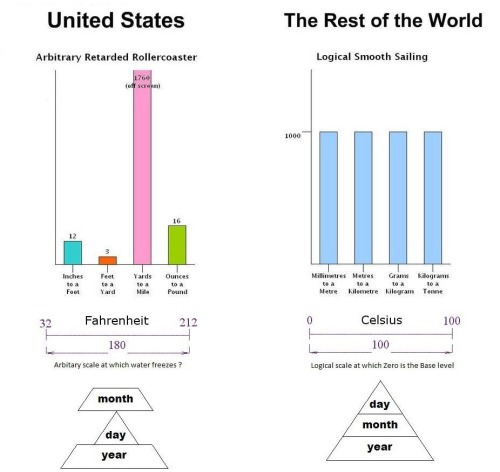
Build Your Own Little Free Library. Check out some others. These too. The scoop and the FAQ.
It being bracket season, The Weather Channel has devised an epic Weather Song tournament for those not interested in college athletics. It consists of four weather-related phenomena, with underdogs and favorites abounding. "Have you Ever Seen the Rain" trounced "the crowd-favorite Weather Girls' It's Raining Men" in the first round of the Rain Region. Eddie Cochran's "Summertime Blues" upset Bananarama's summer-related hit in the Seasons Region. Voting is still open until tomorrow for round two of the Sun and Elements regions.
New Words: All writers love words. Here are a batch of new ones, the winners in the WASHINGTON POST'S annual MENSA INVITATIONAL contest.
This school raised over 600 dollars for charity, but before donating a math teacher wanted to break a world record.... with pennies.
What do all the controls in an airplane cockpit do?
Sunday, March 18, 2012
Photo: Skydiver 13 Miles High
Skydiver jumps from a capsule 13 miles high
Felix Baumgartner sits inside a pressurized capsule before his test jump for Red Bull Stratos over Roswell, New Mexico, on March 15, 2012. A hot air balloon lifted the capsule to a height of 13.60 miles over New Mexico which was above the troposphere and within the stratosphere. For his next jump, Baumgartner plans on breaking the world record for the highest jump by traveling 23 miles up into the stratosphere.
Source: Red Bull Stratos
Astronomy: Mysterious Objects of the EM Spectrum
Mysterious Objects at the Edge of the Electromagnetic Spectrum
NASA’s Fermi Gamma-Ray Telescope is finding hundreds of new objects at the very edge of the electromagnetic spectrum. Many of them have one thing in common: Astronomers have no idea what they are.
Saturday, March 17, 2012
Astronomy: ISS over North U.S. and Canada Lights
This video was taken by the crew of Expedition 30 on board the International Space Station in January 31, 2012 from 06:57:12 to 07:05:15 GMT, on a pass from northwestern Kansas to eastern Quebec.
The crew faced the camera looking behind at the Soyuz as the ISS tracks towards northeast. The video begins looking southwest from the ISS towards Dallas/Forth Worth, Oklahoma City, and Houston. As the pass continues northeast, cities like Kansas City, St. Louis, and Chicago are seen.
The Michigan Peninsula stands out well against the contrast of the Great Lakes as the ISS passes over to Ontario and Quebec, where we can see cities like Toronto and Montreal.
Tech: The Future of the City
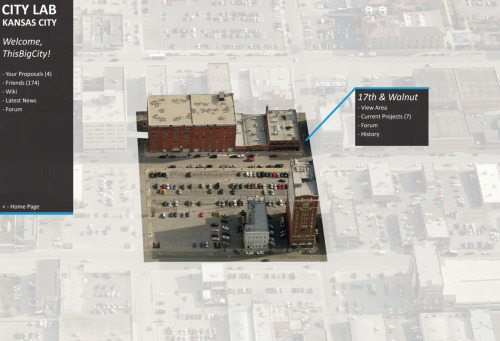
The Future of the City: Crowd-Sourcing & Gamification of City 2.0:
This summer Google will install a 1-gigabyte internet speed cable in Kansas City, which is a hundred times faster than the average broadband cable. This new asset will help revolutionize Kansas City’s technology infrastructure, but no one knows exactly how to utilize it to its fullest potential. Moore proposes a novel idea which could generate interest back toward the city through crowd-sourcing urban design.Source: ThisBigCity
Crowd sourcing and open source first started with computer programmers sharing programs and ideas to create more efficient operating systems, leading to the creation of software like Linux. This process utilizes a large group of experts with diverse backgrounds to help solve a larger problem with data being available for all to access. Although crowd sourcing can provide quick collective knowledge, it can be difficult to maintain the high level of engagement needed for planning cities.
Friday, March 16, 2012
Tech: Open Source Geiger Counter
Designer Andrew Huang created this open source Geiger counter prototype for Safecast, a non-profit organization that is creating a global network of radiation sensors.
The Geiger counter prototype will help expand Safecast’s existing network of more than 135 off the shelf sensors, which are currently set up around Japan to monitor radiation from last year’s Fukushima Daiichi nuclear disaster.
So far, Safecast has collected over 2.7 million measurements around Japan and made the data freely available and can be viewed on a variety of maps.
Event: SXSW 2012 Google Lego Hackathon
This past Sunday at SXSW Google and Lego sponsored a Hackathon at the Google Developers House. The object of the hackathon was to build a Lego Mindstorm robot to navigate an obstacle course. The course was built during the hackathon so the contestants had to design toward a moving target.
The available parts were limited to the a single Mindstorm 2.0 kit and a small assortment of axles and wheels. Lego also made some decorative pieces available during the last couple hours so people could beautify their robots. Prizes were awarded for speed, style, and technical innovation.
The Google Developers LEGO® MINDSTORMS® rumble returns to SXSW this year with even more epic proportions. After teams spend the day building LEGO race bots controlled by Android, the bots will compete in the ultimate showdown to determine the victors. We'll be broadcasting live the main event with multiple camera angles, slow-mo replay, interviews with the teams, and commentary from judges and attendees to give you an insider pass to all the action. You won't want to miss this showdown.
Science: Researchers Use Legos to Build Artificial Bone
Google Science Fair 2012: How can robots aid scientific research?
Researchers at Cambridge University are building artificial bone in the lab, and they’re doing so with what might be considered an unorthodox partner: Lego. The tedious process of building up a sample of artificial bone requires a lot of repetitive dipping of samples into various substances, rinsing, and repeating. So to automate sample creation, the researchers built a couple of inexpensive laboratory robots using Lego Mindstorms.
The robots, as you will see in the video below, handle the sample creation duties, freeing up the human researchers to focus on other laboratory tasks. Which is pretty clever. Lego, for its part, sees an expanding role for itself in the laboratory and in education in general. The company has teamed up with Google for the 2012 Google Science Fair, which is a pretty cool initiative that encourages kids 13 to 18 to solve answer any question that’s been bothering them any which way they can.
Astronomy: Evolution of the Moon
The NASA Goddard Scientific Visualization Studio has created this wonderful short video on the evolution of the moon. The video was created using data from the Lunar Reconnaissance Orbiter.
From year to year, the moon never seems to change. Craters and other formations appear to be permanent now, but the moon didn't always look like this. Thanks to NASA's Lunar Reconnaissance Orbiter, we now have a better look at some of the moon's history. Learn more in this video!
Thursday, March 15, 2012
Video Distraction: Dueling Banjos on Tesla Coils
Two Tesla coils perform a rousing rendition of "Dueling Banjos" in this 2010 video by FONentertainment. Be sure to watch past the one minute mark for maximum dueling.
Science: World’s Largest Sierpenski Triangle
In Eudora, Kansas, you dont give your money to charity until you’ve done something fuggin rad with it first. Raising over $700 in pennies, they set out to beat the world record for world’s largest Sierpenski triangle. Nine hours and over 60,000 pennies later, the massive copper Triforce was complete. Time to make a wish, guys! I sincerely hope there isn't evil in your hearts.
Tech Links: Anonymous-OS

Anonymous has just released Anonymous-OS, their own Ubuntu-based operating system that uses the MATE desktop environment. It was created to help check the security of web pages for educational purposes and is available for download through SouceForge ...at your own risk, of course.
Science: The Day we Stopped Dreaming About Tomorrow
The intention of this project is to stress the importance of advancing the space frontier and is focused on igniting scientific curiosity in the general public.
Wednesday, March 14, 2012
Tech Links: March 14, 2012
Clever advertising at SXSW: A human charging station by FedEx
Entertainment
Alan Turing's report cards, going back to grade school should prove encouraging to those of you who love computers but aren't great students.
Ever wonder what a GPS looks like on an airplane?
‘KONY 2012′ Tops 100 Million Views, Becomes the Most Viral Video in History
Organizers Defend "Homeless Hotspots" at SXSW (More)
Video Distraction: Vi Hart's Pi Day Play
Are Shakespeare's Plays Encoded within Pi?
Tech Links: Poll Everywhere
Tech: Muscle tissue produced with a 3D printer

Muscle tissue produced with a 3D printer:
San Diego startup Organovo has developed a bioprinting technique which allows it to create human tissue starting with any cell source. The printer deposits lines of cells closely together, where they are allowed to grow and interconnect until they form working muscle tissue.
Source: MFoundation Blog
San Diego startup Organovo has developed a bioprinting technique which allows it to create human tissue starting with any cell source. The printer deposits lines of cells closely together, where they are allowed to grow and interconnect until they form working muscle tissue.
Unlike other experimental approaches that utilize ink-jet printers to deposit cells, Organovo’s technology enables cells to interact with each other the way they do in the body. How? They are packed tightly together, sandwiched, if you will, and incubated. This prompts them to cleave to each other and interchange chemical signals. When printed, the cells are grouped together in a paste that helps them grow, migrate, and align themselves properly. In the case of muscle cells, the way they orient themselves in the same direction allow for contractions of the tissue.The company hopes to one day build entire organs for transplants. Because tissue is able to be built from a patient’s own cells, the risk of rejection would be very low.
Source: MFoundation Blog
Humor: How to keep Google from watching your searches
Infographic: The Personal Analytics of My Life
Steven Wolfram: The Personal Analytics of My Life:
One day I’m sure everyone will routinely collect all sorts of data about themselves. But because I’ve been interested in data for a very long time, I started doing this long ago. I actually assumed lots of other people were doing it too, but apparently they were not. And so now I have what is probably one of the world’s largest collections of personal data.Source: Steven Wolfram Blog
Every day—in an effort at “self awareness”—I have automated systems send me a few emails about the day before. But even though I’ve been accumulating data for years—and always meant to analyze it—I’ve never actually gotten around to doing it. But with Mathematica and the automated data analysis capabilities we just released in Wolfram|Alpha Pro, I thought now would be a good time to finally try taking a look—and to use myself as an experimental subject for studying what one might call “personal analytics”.
Video Distraction: Man excavates basement with R/C models
Man excavates his basement using only R/C models:
It took seven years for Joe Murray to excavate the basement of his home in Saskatchewan Canada using only radio controlled vehicles. Using r/c drills, excavators, haulers, and trucks, the strange technique meant he never even had to get his hands dirty.
Each Winter he mines the walls of his unfinished basement and then hauls the dirt out each summer. He once had a conveyor belt, but now uses a spiral ramp for removal. Murray estimates that he has excavated about 2 to 3 cubic yards of dirt every year for the past seven years. The motivation behind the project is fairly simple: Murray like R/C, and he likes working in his basement over long cold Saskatchewan Winters. He first got interested in the craft back in 1996, and is now modifying and repairing his own vehiclesYou can check out his YouTube channel here, which has over 150 videos with over 4 million views and counting.
Source: Singularity Hub
Tech Links: New Rdio
New Rdio is a visually beautiful and dynamic way to play Rdio’s massive catalogue of 15 million songs. New features include the oft requested drag and drop playlist creation, a more personalized Heavy Rotation, and private playlists.
The completely redesigned new Rdio is available on Rdio.com and the Rdio desktop apps to all Web and Unlimited subscribers. Switch on new Rdio from the drop down menu under your name and “Try New Rdio.”
Net: Spotify on the future of streaming music
Spotify on the future of streaming music: 'We want to cannibalize piracy':
Today's the transition day between SXSW Interactive and the start of the much larger and arguably more interesting SXSW Music festival, so it's only fitting that Spotify, Rdio, and turntable.fm all held events and keynotes this morning. But while Rdio launched a total redesign and turntable.fm announced a series of major label deals, Spotify's chief content officer Ken Parks instead held a thoughtful panel called "The Future of Music" with Billboard editorial director Bill Werde and Disturbed singer David Draiman. The contrast was stark: while Rdio is in the middle of a full-on competitive reinvention and turntable.fm is just signing the paperwork that enables its business, Spotify is talking about nothing less than saving the music industry from itself. "We've taken millions of people used to stealing music and gotten them to pay more than their fair share," Parks said in an interview after the panel. "By historical standards, someone spending $120 a year is spending a lot of money on music."Source: The Verge
And make no mistake — the total amount of money is enormous. Parks told the room that Spotify now has some 10 million monthly active users, of which some three million pay for premium subscriptions, and that the company has already paid out some $250 million to rightsholders. "By the millions there were dedicated pirates who now don't see a reason to pirate," because of Spotify, he said. "Before Spotify there was no market in places like Sweden."
Of course, the biggest issue for streaming services right now is buy-in from artists unhappy with minuscule per-stream royalty rates estimated to be just a fiftieth of per-download rates, but Parks and Draiman repeatedly called such comparisons "asinine." "What should matter is how many people are being monetized and the rate of that monetization," said Parks, with Draiman saying artists obsessed with per-stream rates are "cutting off their nose to spite their face." Parks was even more blunt after the panel, saying that artists "trying to put the genie back in the bottle" by holding out on streaming services are "on the wrong side of history and technology and progress."
Net: PayPal Redesign

PayPal Redesigns How You Buy With Its "Digital Wallet":
Your money is a mess. In principle, you've got this pot of it somewhere. But trying to use it actually turns out to be a headache and a hassle. Which card should you use at any given time? Why do you have to pull out so many bits of paper and plastic when you've got a coupon, a gift card, and a credit card to use at the same store?Source: Fast Company
PayPal agrees. That's why the company introduced a new set of digital wallet tools today at the SXSW conference in Austin, TX. It's the first time in the company's 13-year history that it's redesigned and re-architected the system's payments experience, Sam Shrauger, PayPal's vice president of global product and experience, tells Fast Company.
"When we started, we were about making money work better on the web," he said. "This is about making money work better everywhere."
News: 38% of China’s Internet mobile-only users
38% of China’s Internet population are mobile-only users, says report:
Mobile-only Web users account for more than one third of China’s Internet population, according to a report from mobile research specialist On Device. The study found that the country’s rural population drove an annual 8 percent increase in mobile-only Web usage, which accounted for 38 percent of China’s Internet users in 2011.Source: The Next Web
Link Round-Up: Pi Day
For Pi Day, Shannon at a periodic table has created the apple Pi, a wonderfully clever apple pie where the fruit and crust adornments are cut into numbers. Via: A Periodic Table
I think it’s safe to say this may be the geekiest baking project I’ve done to date. And that’s saying something, as I am prone to geeking out in the kitchen a wee little bit. I mean, it’s a pie made entirely of apple numbers. And then topped with more numbers, this time of the crust variety. Oh, and not only numbers, you see, but the numbers of that beloved symbol of Nerdland (and I mean that in a good way), Pi.
Video Distraction: Desktop Diaries
What does Neil deGrasse Tyson keep on his desk? National Public Radio’s Science Friday has recently released a series of brief interviews in which popular scientists discuss their personal working space. Lighthearted and occasionally poignant, these short videos offer rare candid looks at the men behind the public personas.
Monday, March 12, 2012
Interview: Ralph Baer
Photographer David Friedman recently interviewed Ralph Baer, the inventor of the home video game console. Baer’s game system, the Magnavox Odyssey, was released 40 years ago, in 1972. Baer is now 90 years old and still inventing. The interview is part of Friedman’s wonderful Inventor Portrait series.
Friday, March 9, 2012
Video Distraction: Motion Capture on Playstation 3
“Kara” is an impressive demonstration of a new motion capture engine in development for Playstation 3 by French game studio Quantic Dream. The studio previously used motion capture technology for their 2010 interactive drama game, Heavy Rain. The new engine will be used in an upcoming game for Playstation 3.
Labels:
graphic design,
technology,
video,
video games
Thursday, March 8, 2012
Daily Links: March 5, 2012
A Closer Look At McDonald’s France’s “Dark Vader Burger”
Create your own chemical Hand Warmers this winter using ziplock bags.
Eat Ramen Without Guilt!
"Ever wish you could see the strands of genetic material that make you...you?" NOVA shows you how to extract your DNA with this do-it-yourself tutorial using household items.
Featuring nearly 300 penguins, San Diego's PenguinCam provides hours of entertainment during March and April.
How to Host a Dungeon is a solitaire pen-and-paper game in which you create an underground complex of rooms, populate them with various fantasy races and monsters, and simulate its history. At almost any time you can stop and have the basis for a D&D campaign. Here's a playthrough of a game. (Part 2) The first edition is free; the expanded second edition costs $5 for a PDF download. The site contains many additional example playthroughs.
Robot Quadrotors Perform James Bond Theme
The Top 100 First World Problems, at least from a young single guy’s point of view.
Science: Earth’s Magnetic Field
Earth’s magnetic field provides vital protection
A chance alignment of planets during a passing gust of the solar wind has allowed scientists to compare the protective effects of Earth’s magnetic field with that of Mars’ naked atmosphere. The result is clear: Earth’s magnetic field is vital for keeping our atmosphere in place.
Wednesday, March 7, 2012
Tech Links: March 7, 2012

A study by the Analysis Group commissioned by Apple estimates that Apple has created roughly 514,000 jobs in the USA.
Entertainment
Infographic: 60 Seconds in Social Media
Infographic: Top 10 largest IPOs
News
Employers and colleges are now asking applicants for their Facebook logins and passwords in an attempt to get around privacy settings.
Law enforcement agents on two continents swooped in on top members of the infamous computer hacking group LulzSec early this morning
NASA concerned about cyber attacks
Police Drone Crashes Into Police
Reading & Discussion
Is Privacy Dead? A conversation. "For the entirety of human history, we have operated on small scales and in relative anonymity. Our words are heard by the few people close to us and most are quickly forgotten. We walk down the street without passers-by knowing our names or history. The internet has started to change that.
Facebook Can Tell You If A Person Is Worth Hiring
Resources & Software
Oldmapsonline is a central repository of maps held by institutions across the globe. It features over 60,000 maps.
Tutorials
How to root the Nook Tablet
Top 10 Pro Tips and Tools for Budding Web Developers and Designers
News: Hackers Steal Archive of Jackson Tracks
Hackers Allegedly Steal Sony’s Archive Of 50k+ Michael Jackson Tracks:
Hackers reportedly illegally downloaded over Michael Jackson’s entire back catalog, consisting of 50,000 tracks, many never released. Sony purchased the catalog from Jackson’s estate for $250 (£157.51) million last year. W.E.N.N. reports, “The attack was discovered weeks after hackers targeted Sony’s PlayStation Network in April, but was only confirmed by a Sony Music representative on Saturday.The UK’s Daily Star reports, "Record bosses only discovered the theft of 50,000 music files when a worker saw Jackson fans chatting about it on forums."Source: PaidContent
Media: How Newspapers are Build Digital Revenue
Pew Research’s Project for Excellence in Journalism just released “The Search for a New Business Model,” a study “which combines detailed proprietary data from individual
newspapers with in-depth interviews at more than a dozen major media
companies” in order to understand how newspapers are digitally
innovating or otherwise trying to stymie their rapidly disappearing
print revenues. The study reveals just how abysmal the on-going efforts of newspapers really are.
Here’s the long and short of the article:
Here’s the long and short of the article:
- Digital revenues aren’t even close to covering print losses. For every $11 in print revenue, papers brought in $1 in digital revenue. Put a more depressing way: for every $1 gained in digital $7 are lost in print revenue.
- Newspapers don’t know how to sell digital advertising. Papers are barely selling targeted advertising. Instead, they choose (or only know how) to sell discrete display advertising campaigns. Such campaigns cannot scale to the scale of their audience and reduce the value of digital sales efforts by a factor or two.
- Newspapers are unable to hire digital talent. The majority of executives said it’s almost impossible to hire digitally fluent sales people, due to newspapers’ bad digital repuations. Further, even if they can hire digital talent they haven’t figured out how to integrate digital sales people with their traditional sales personnel.
- Newspapers don’t want to think about digital. A surveyed executive worries that they spend too much time working on digital, “We spend 90% of our time talking about 10% of our revenue.” A number of executives expressed concern that they have “too many people-whether it be in the newsroom, the boardroom or on the sales staff-who were too attached to the old way of doing things.”
News: Robo-cheetah sets speed record
Robo-cheetah sets speed record:
If there's anything scarier than a cheetah coming after you, it would have to be a headless robo-cheetah coming after you at record speed. That nightmare is now a reality, thanks to DARPA's Cheetah robot, whose 18 mph pace has set a land speed record for machines with legs.Source: Cosmic Log
The feat, revealed today on the Defense Advanced Research Projects Agency's website, is aimed at developing combat robots that can outrun and evade humans on foot — and a 3:20 mile should just about do it. (The world record for humans is 3:43.) Boston Dynamics has been working on the cheetah-bot as part of DARPA's Maximum Mobility and Manipulation program, or M3.
"This robot is galloping," Boston Dynamics President Marc Raibert told the Boston Globe. "It's the first time we've had a robot that gallops."
The previous record for legged robots was 13.1 mph, set in 1989 by the MIT Leg Lab's stick-figurish Planar Biped robot. For what it's worth, flesh-and-blood cheetahs can still run much faster, zooming at up to 70 mph.
Video Distraction: Space Mountain Lights On
Space mountain at the Disneyland Resort in Anaheim with the lights on. This was filmed during a special cast member ride through and after we went on it with the lights on they sent us through again but with all the lights off including the stars.
Lecture: The Greatest Hits of Hacks
Avi Rubin, professor of computer science and director of Health and Medical Security Lab at Johns Hopkins University, gives us a run-down of some incredible hacks and attacks that he and others in the field of computer security have managed to successfully perform.
It’s pretty terrifying that they manage to hack everything from getting a car to indicate it’s going slower on the speedometer than it actually is to measuring fluctuations in the accelerometer of a smartphone next to your keyboard to find out what’s being typed on that keyboard to getting internal defibrillators to shock your heart (and kill you).
WARNING: May make you wish you were Amish.
Photo: Lamborghini Aventador

Lamborghini Aventador
We're all about one step away from all driving Batmobiles. I love it.
Subscribe to:
Comments (Atom)







